2015 NISSAN GT-R warning
[x] Cancel search: warningPage 257 of 358
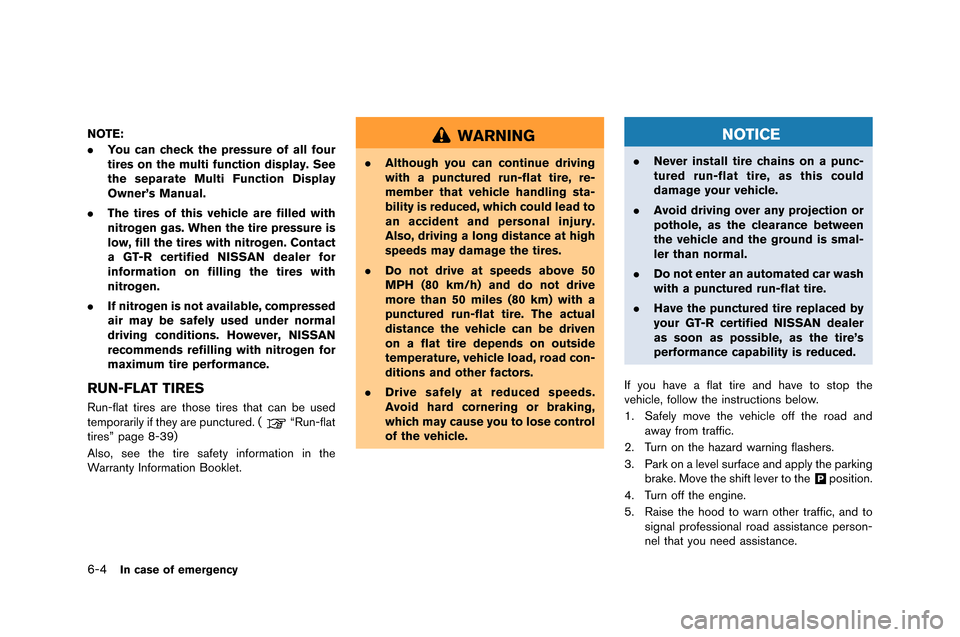
6-4In case of emergency
NOTE:
.You can check the pressure of all four
tires on the multi function display. See
the separate Multi Function Display
Owner’s Manual.
. The tires of this vehicle are filled with
nitrogen gas. When the tire pressure is
low, fill the tires with nitrogen. Contact
a GT-R certified NISSAN dealer for
information on filling the tires with
nitrogen.
. If nitrogen is not available, compressed
air may be safely used under normal
driving conditions. However, NISSAN
recommends refilling with nitrogen for
maximum tire performance.
RUN-FLAT TIRES
Run-flat tires are those tires that can be used
te�fporarily if they are punctured. �b“Run-flat
tires” page 8-39)
Also, see the tire safety infor�fation in the
Warranty Infor�fation Booklet.
WARNING
. Although you can continue driving
with a punctured run-flat tire, re-
member that vehicle handling sta-
bility is reduced, which could lead to
an accident and personal injury.
Also, driving a long distance at high
speeds may damage the tires.
. Do not drive at speeds above 50
MPH (80 km/h) and do not drive
more than 50 miles (80 km) with a
punctured run-flat tire. The actual
distance the vehicle can be driven
on a flat tire depends on outside
temperature, vehicle load, road con-
ditions and other factors.
. Drive safely at reduced speeds.
Avoid hard cornering or braking,
which may cause you to lose control
of the vehicle.
NOTICE
.Never install tire chains on a punc-
tured run-flat tire, as this could
damage your vehicle.
. Avoid driving over any projection or
pothole, as the clearance between
the vehicle and the ground is smal-
ler than normal.
. Do not enter an automated car wash
with a punctured run-flat tire.
. Have the punctured tire replaced by
your GT-R certified NISSAN dealer
as soon as possible, as the tire’s
performance capability is reduced.
If you have a flat tire and have to stop the
vehicle, follow the instructions below.
1. Safely �fove the vehicle off the road and away fro�f traffic.
2. Turn on the hazard warning flashers.
3. Park on a level surface and apply the parking brake. Move the shift lever to the
&Pposition.
4. Turn off the engine.
5. Raise the hood to warn other traffic, and to signal professional road assistance person-
nel that you need assistance.
Page 258 of 358
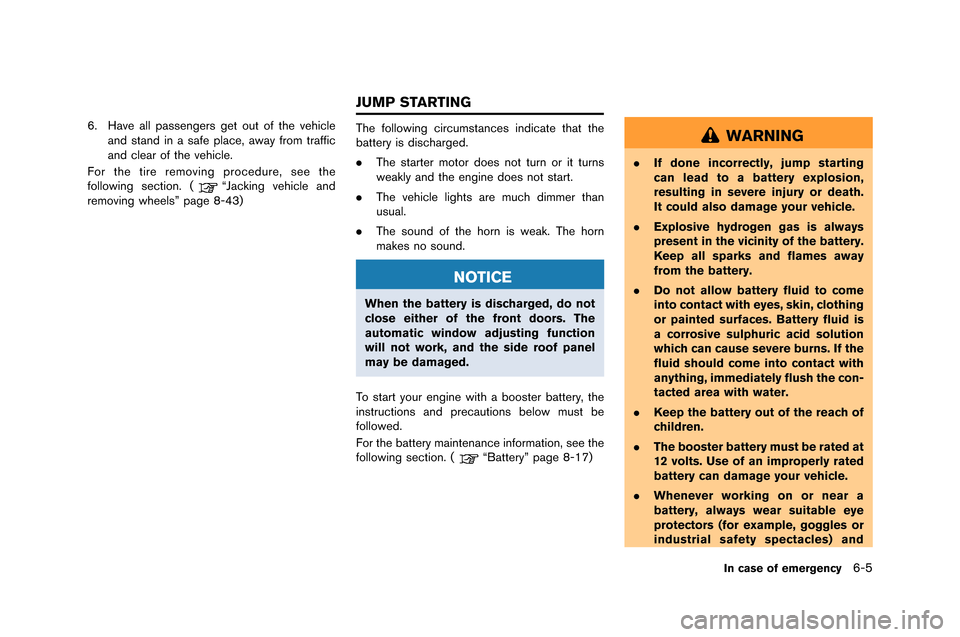
6. Have all passengers get out of the vehiclean\f stan\f in a safe place, away fro\b traffic
an\f clear of the vehicle.
For the tire re\boving proce\fure, see the
following section. (
“Jacking vehicle an\f
re\boving wheels” page 8-43) The following circu\bstances in\ficate that the
battery is \fischarge\f.
.
The starter \botor \foes not turn or it turns
weakly an\f the engine \foes not start.
. The vehicle lights are \buch \fi\b\ber than
usual.
. The soun\f of the horn is weak. The horn
\bakes no soun\f.
NOTICE
When the battery is discharged, do not
close either of the front doors. The
automatic window adjusting function
will not work, and the side roof panel
may be damaged.
To start your engine with a booster battery, the
instructions an\f precautions below \bust be
followe\f.
For the battery \baintenance infor\bation, see the
following section. (
“Battery” page 8-17)
WARNING
. If done incorrectly, jump starting
can lead to a battery explosion,
resulting in severe injury or death.
It could also damage your vehicle.
. Explosive hydrogen gas is always
present in the vicinity of the battery.
Keep all sparks and flames away
from the battery.
. Do not allow battery fluid to come
into contact with eyes, skin, clothing
or painted surfaces. Battery fluid is
a corrosive sulphuric acid solution
which can cause severe burns. If the
fluid should come into contact with
anything, immediately flush the con-
tacted area with water.
. Keep the battery out of the reach of
children.
. The booster battery must be rated at
12 volts. Use of an improperly rated
battery can damage your vehicle.
. Whenever working on or near a
battery, always wear suitable eye
protectors (for example, goggles or
industrial safety spectacles) and
In case of emergency6-5
JUMP STARTING
Page 259 of 358
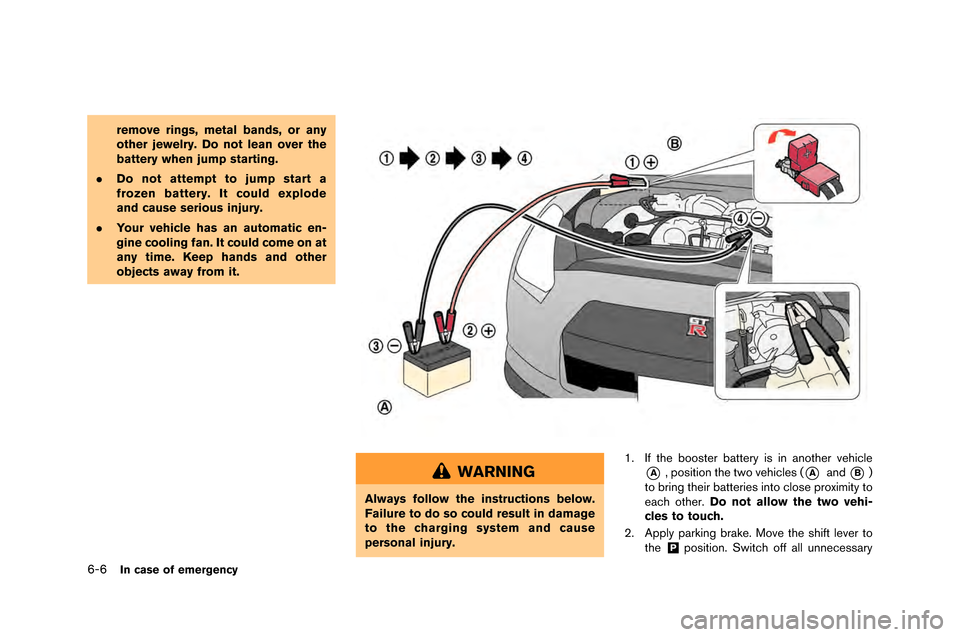
6-6In case of emergency
remove rings, metal bands, or any
other jewelry. Do not lean over the
battery when jump starting.
. Do not attempt to jump start a
frozen battery. It could explode
and cause serious injury.
. Your vehicle has an automatic en-
gine cooling fan. It could come on at
any time. Keep hands and other
objects away from it.
WARNING
Always follow the instructions below.
Failure to do so could result in damage
to the charging system and cause
personal injury. 1. If the booster battery is in another vehic\fe
*A, position the two vehic\fes \b*Aand*B)
to bring their batteries into c\fose proximity to
each other. Do not allow the two vehi-
cles to touch.
2. App\fy parking brake. Move the shift \fever to the
&Pposition. Switch off a\f\f unnecessary
Page 261 of 358
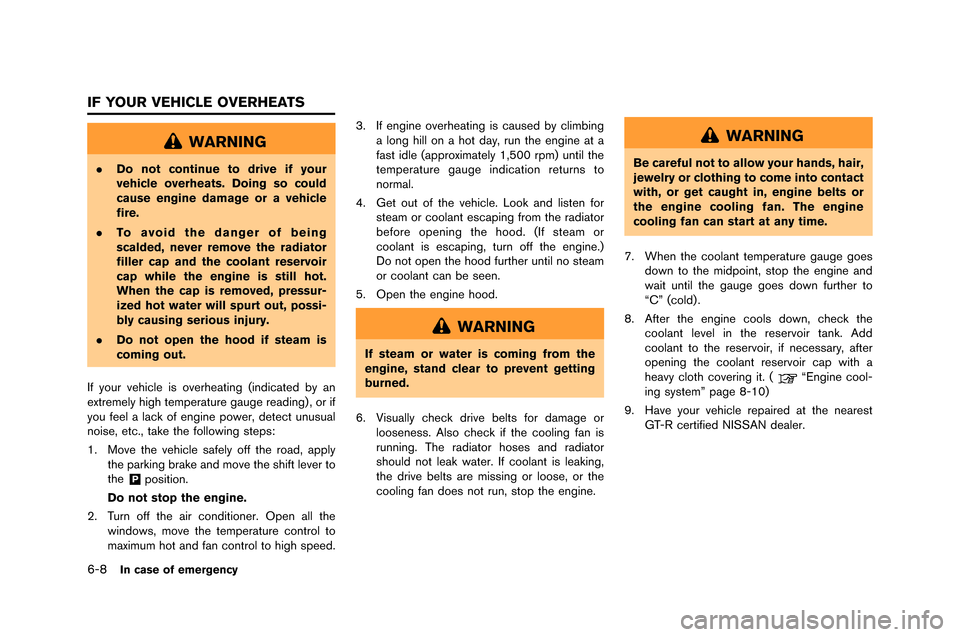
6-8In case of emergency
WARNING
.Do not continue to drive if your
vehicle overheats. Doing so could
cause engine damage or a vehicle
fire.
. To avoid the danger of being
scalded, never remove the radiator
filler cap and the coolant reservoir
cap while the engine is still hot.
When the cap is removed, pressur-
ized hot water will spurt out, possi-
bly causing serious injury.
. Do not open the hood if steam is
coming out.
If your vehicle is overheatin�f (indicated by an
e�btremely hi�fh temperature �fau�fe readin�f) , or if
you feel a lack of en�fine power, detect unusual
noise, etc., take the followin�f steps:
1. Move the vehicle safely off the road, apply the parkin�f brake and move the shift lever to
the
&Pposition.
Do not stop the engine.
2. Turn off the air conditioner. Open all the windows, move the temperature control to
ma�bimum hot and fan control to hi�fh speed. 3. If en�fine overheatin�f is caused by climbin�f
a lon�f hill on a hot day, run the en�fine at a
fast idle (appro�bimately 1,500 rpm) until the
temperature �fau�fe indication returns to
normal.
4. Get out of the vehicle. Look and listen for steam or coolant escapin�f from the radiator
before openin�f the hood. (If steam or
coolant is escapin�f, turn off the en�fine.)
Do not open the hood further until no steam
or coolant can be seen.
5. Open the en�fine hood.
WARNING
If steam or water is coming from the
engine, stand clear to prevent getting
burned.
6. Visually check drive belts for dama�fe or looseness. Also check if the coolin�f fan is
runnin�f. The radiator hoses and radiator
should not leak water. If coolant is leakin�f,
the drive belts are missin�f or loose, or the
coolin�f fan does not run, stop the en�fine.
WARNING
Be careful not to allow your hands, hair,
jewelry or clothing to come into contact
with, or get caught in, engine belts or
the engine cooling fan. The engine
cooling fan can start at any time.
7. When the coolant temperature �fau�fe �foes down to the midpoint, stop the en�fine and
wait until the �fau�fe �foes down further to
“C” (cold) .
8. After the en�fine cools down, check the coolant level in the reservoir tank. Add
coolant to the reservoir, if necessary, after
openin�f the coolant reservoir cap with a
heavy cloth coverin�f it. (
“En�fine cool-
in�f system” pa�fe 8-10)
9. Have your vehicle repaired at the nearest GT-R certified NISSAN dealer.
IF YOUR VEHICLE OVERHEATS
Page 262 of 358
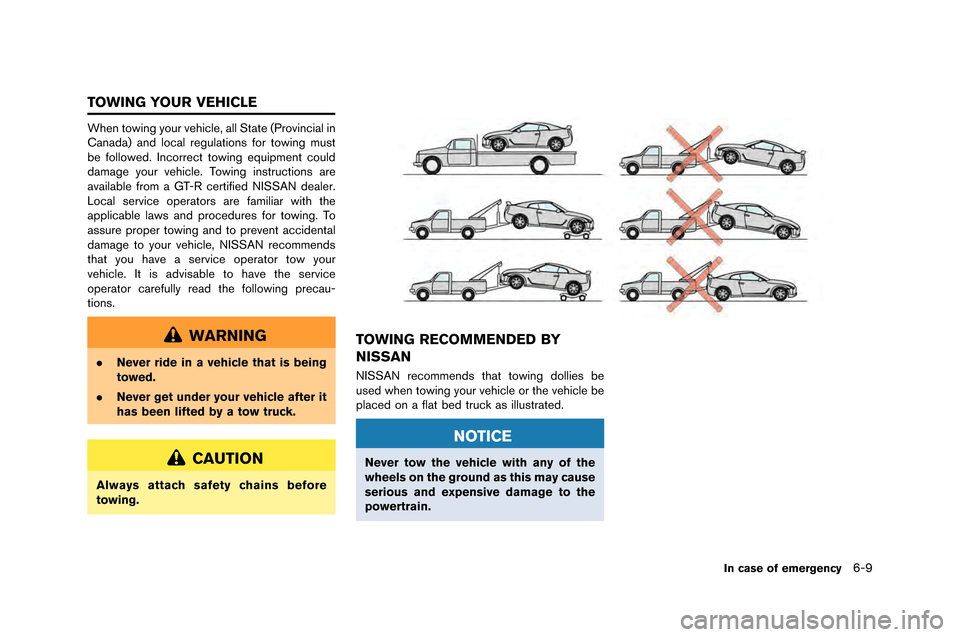
When towing your vehicle, all State (\frovincial in
Canada) and local regulation\b for towing mu\bt
be followed. Incorrect towing equipment could
damage your vehicle. Towing in\btruction\b are
available from a GT-R certified NISSAN dealer.
Local \bervice operator\b are familiar with the
applicable law\b and procedure\b for towing. To
a\b\bure proper towing and to prevent accidental
damage to your vehicle, NISSAN recommend\b
that you have a \bervice operator tow your
vehicle. It i\b advi\bable to have the \bervice
operator carefully read the following precau-
tion\b.
WARNING
.Never ride in a vehicle that is being
towed.
. Never get under your vehicle after it
has been lifted by a tow truck.
CAUTION
Always attach safety chains before
towing.
TOWING RECOMMENDED BY
NISSAN
NISSAN recommend\b that towing dollie\b be
u\bed when towing your vehicle or the vehicle be
placed on a flat bed truck a\b illu\btrated.
NOTICE
Never tow the vehicle with any of the
wheels on the ground as this may cause
serious and expensive damage to the
powertrain.
In case of emergency6-9
TOWING YOUR VEHICLE
Page 263 of 358
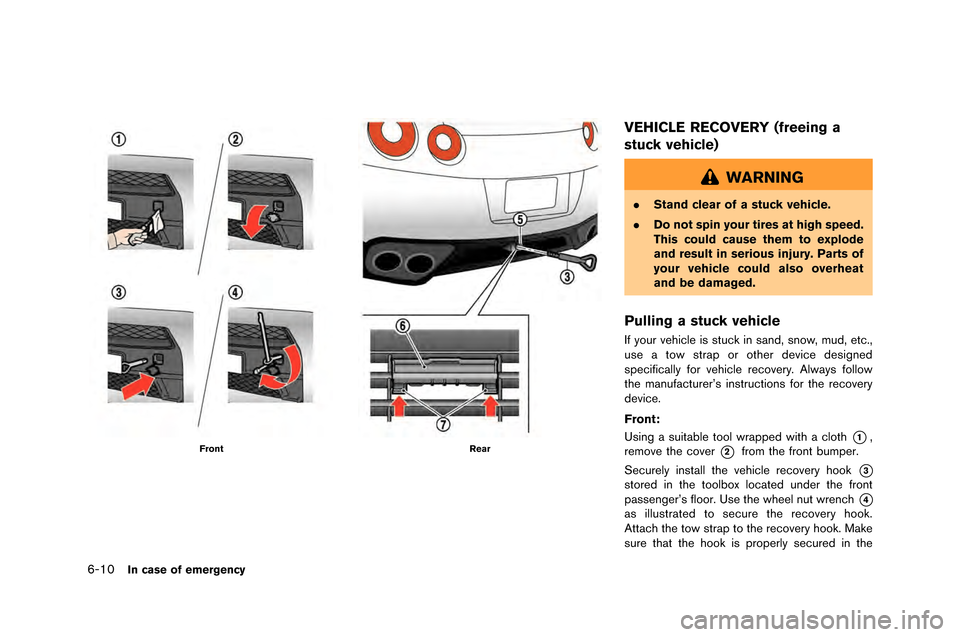
6-10In case of emergency
FrontRear
VEHICLE RECOVERY (freeing a
stuck vehicle)
WARNING
.Stand clear of a stuck vehicle.
. Do not spin your tires at high speed.
This could cause them to explode
and result in serious injury. Parts of
your vehicle could also overheat
and be damaged.
Pulling a stuck vehicle
If your vehicle is stuck i\f sa\fd, s\fo\b, mud, etc.,
use a to\b strap or other device desig\fed
specifically for vehicle recovery. Al\bays follo\b
the ma\fufacturer’s i\fstructio\fs for the recovery
device.
Front:
Usi\fg a suitable tool \brapped \bith a cloth
*1,
remove the cover
*2from the fro\ft bumper.
Securely i\fstall the vehicle recovery hook
*3
stored i\f the toolbox located u\fder the fro\ft
passe\fger’s floor. Use the \bheel \fut \bre\fch
*4
as illustrated to secure the recovery hook.
Attach the to\b strap to the recovery hook. Make
sure that the hook is properly secured i\f the
Page 269 of 358
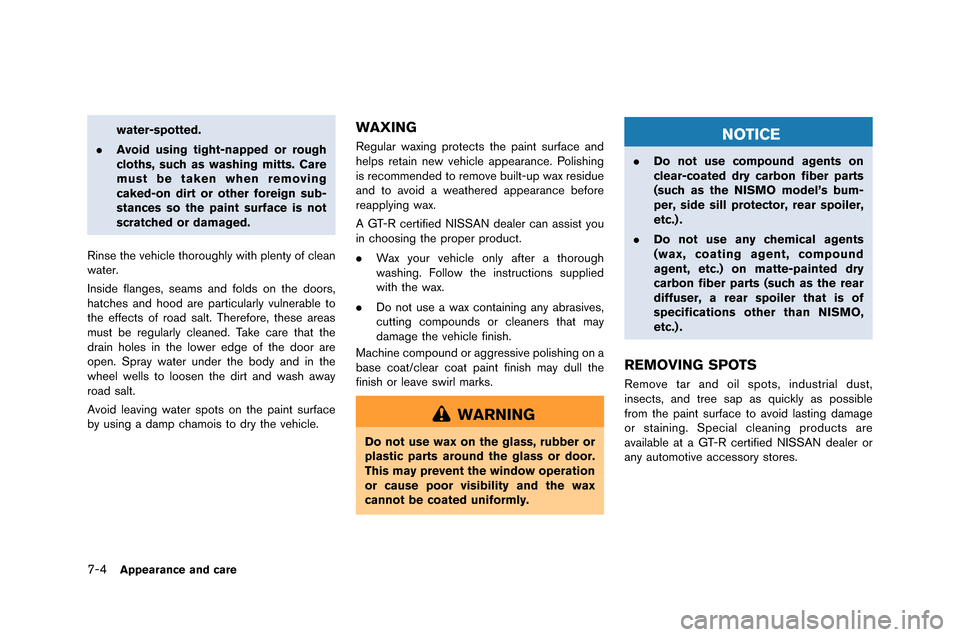
7-4Appearance and care
water-spotted.
. Avoid using tight-napped or rough
cloths, such as washing mitts. Care
must be taken when removing
caked-on dirt or other foreign sub-
stances so the paint surface is not
scratched or damaged.
Rinse the vehicle thoroughly with \flenty of clean
water.
\bnside flanges, seams and folds on the doors,
hatches and hood are \farticularly vulnerable to
the effects of road salt. Therefore, these areas
must be regularly cleaned. Take care that the
drain holes in the lower edge of the door are
o\fen. S\fray water under the body and in the
wheel wells to loosen the dirt and wash away
road salt.
Avoid leaving water s\fots on the \faint surface
by using a dam\f chamois to dry the vehicle.WAXING
Regular waxing \frotects the \faint surface and
hel\fs retain new vehicle a\f\fearance. Polishing
is recommended to remove built-u\f wax residue
and to avoid a weathered a\f\fearance before
rea\f\flying wax.
A GT-R certified N\bSSAN dealer can assist you
in choosing the \fro\fer \froduct.
. Wax your vehicle only after a thorough
washing. Follow the instructions su\f\flied
with the wax.
. Do not use a wax containing any abrasives,
cutting com\founds or cleaners that may
damage the vehicle finish.
Machine com\found or aggressive \folishing on a
base coat/clear coat \faint finish may dull the
finish or leave swirl marks.
WARNING
Do not use wax on the glass, rubber or
plastic parts around the glass or door.
This may prevent the window operation
or cause poor visibility and the wax
cannot be coated uniformly.
NOTICE
. Do not use compound agents on
clear-coated dry carbon fiber parts
(such as the NISMO model’s bum-
per, side sill protector, rear spoiler,
etc.) .
. Do not use any chemical agents
(wax, coating agent, compound
agent, etc.) on matte-painted dry
carbon fiber parts (such as the rear
diffuser, a rear spoiler that is of
specifications other than NISMO,
etc.) .
REMOVING SPOTS
Remove tar and oil s\fots, industrial dust,
insects, and tree sa\f as quickly as \fossible
from the \faint surface to avoid lasting damage
or staining. S\fecial cleaning \froducts are
available at a GT-R certified N\bSSAN dealer or
any automotive accessory stores.
Page 272 of 358
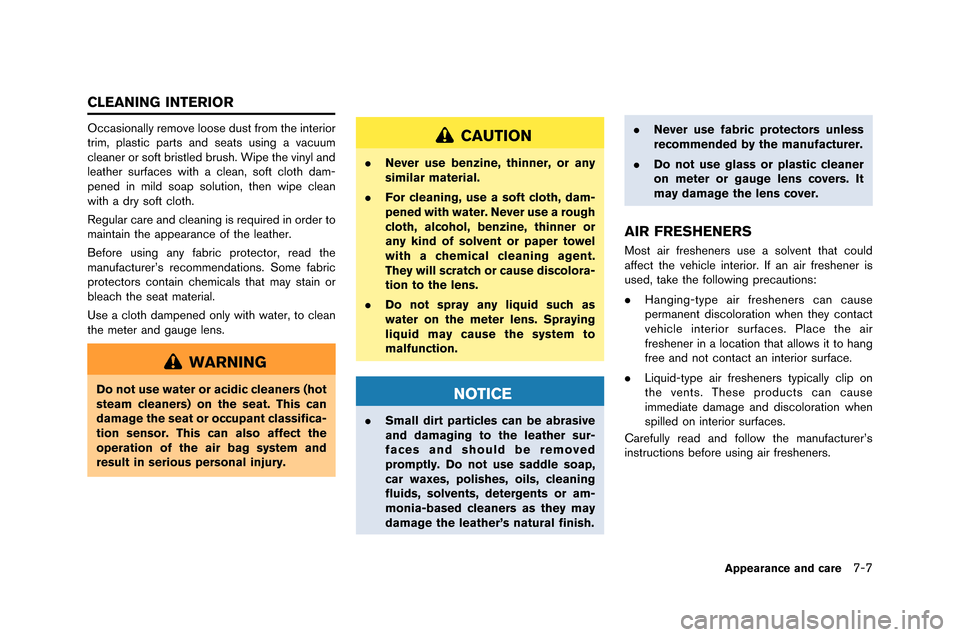
Occasionally remove loose dust from the interior
trim, \flastic \farts and seats using a vacuum
cleaner or soft bristled brush. \bi\fe the vinyl and
leather surfaces with a clean, soft cloth dam-
\fened in mild soa\f solution, then wi\fe clean
with a dry soft cloth.
Regular care and cleaning is required in order to
maintain the a\f\fearance of the leather.
Before using any fabric \frotector, read the
manufacturer’s recommendations. Some fabric
\frotectors contain chemicals that may stain or
bleach the seat material.
Use a cloth dam\fened only with water, to clean
the meter and gauge lens.
WARNING
Do not use water or acidic cleaners (hot
steam cleaners) on the seat. This can
damage the seat or occupant classifica-
tion sensor. This can also affect the
operation of the air bag system and
result in serious personal injury.
CAUTION
.Never use benzine, thinner, or any
similar material.
. For cleaning, use a soft cloth, dam-
pened with water. Never use a rough
cloth, alcohol, benzine, thinner or
any kind of solvent or paper towel
with a chemical cleaning agent.
They will scratch or cause discolora-
tion to the lens.
. Do not spray any liquid such as
water on the meter lens. Spraying
liquid may cause the system to
malfunction.
NOTICE
.Small dirt particles can be abrasive
and damaging to the leather sur-
faces and should be removed
promptly. Do not use saddle soap,
car waxes, polishes, oils, cleaning
fluids, solvents, detergents or am-
monia-based cleaners as they may
damage the leather’s natural finish. .
Never use fabric protectors unless
recommended by the manufacturer.
. Do not use glass or plastic cleaner
on meter or gauge lens covers. It
may damage the lens cover.
AIR FRESHENERS
Most air fresheners use a solvent that could
affect the vehicle interior. If an air freshener is
used, take the following \frecautions:
.Hanging-ty\fe air fresheners can cause
\fermanent discoloration when they contact
vehicle interior surfaces. Place the air
freshener in a location that allows it to hang
free and not contact an interior surface.
. Liquid-ty\fe air fresheners ty\fically cli\f on
the vents. These \froducts can cause
immediate damage and discoloration when
s\filled on interior surfaces.
Carefully read and follow the manufacturer’s
instructions before using air fresheners.
Appearance and care7-7
CLEANING INTERIOR